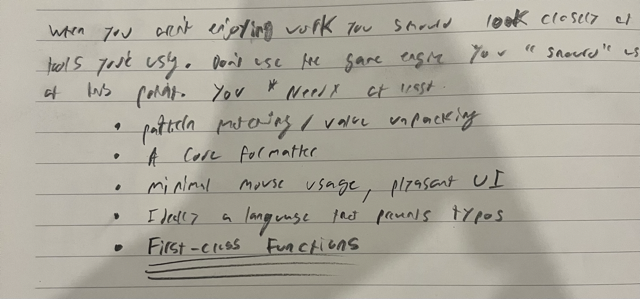Questions to ask when I don't want to work
Treating myself a little more kindly
Apr 2, 2024
Sometimes I don’t want to work. Not wanting to work makes me feel bad.
My identity is tied up in liking to work hard! And I work for myself - it’s very easy to slack off. Not wanting to work makes me feel lazy. It makes me feel like I need to buckle down, and I feel like something is wrong with me when I can’t.
This used to make me upset. I’d spend days distracted, neither fully working nor fully relaxing. Now when this happens I tell myself:
You love to work. That hasn’t changed.
Something else needs to.
This reframing has been a revelation for me. Thinking this way makes it easier to change my process, helps me find what excites me, and makes it easier to consciously take breaks. Here are some questions I ask in order to isolate what needs to change.
The questions
- Does my project have a name? Can I give it one?
- Can I picture my project’s end result? If I can’t, what can I change so that I can?
- Do I know the remaining steps? Can I write them down?
- Can I tell someone what I’m working on? Am I excited to do that?
- Do I like my tools? Should I change them?
- Can I work from somewhere else?
- Do I like what I’m working on? Should I change it?
- Would taking the day off make me feel good? Or would it make me feel bad?
- Am I bored?
- When’s the last time I played a game I loved?
- …or watched a movie I loved?
- …or hung out with someone I loved?
- Have I exercised recently?
- Have I played enough piano this week?
- Can I go for a walk?
These questions fall into three loose categories.
Getting excited about work
Sometimes I need a shot of enthusiasm about an existing project to get it over the finish line. My enthusiasm comes from two places:
- Internal enthusiasm: getting myself excited about what I’m doing
- External enthusiasm: seeing others excited about what I’m doing
Internal enthusiasm
My friend Max once compared internal enthusiasm to how lightning strikes. After building up an electrical field, lightning traces a path of molecules between the cloud and the ground. It creeps down in short jumps, planning a route and identifying its target. And then suddenly the path is known, the molecules are aligned and ionized, and lightning strikes.

the eiffel tower prepares to put flappy bird inside macos finder
Missing internal enthusiasm often means my molecules haven’t aligned yet - I don’t know the path I’m taking or can’t fully picture the target that I’m striking. When I don’t know the path I can feel overwhelmed or unsure of where to start, which leads to high startup costs and work sessions that feel sluggish. And when I can’t picture the target - when I can’t already feel how I’ll feel when it’s done - it’s harder for me to get excited. This is a problem because excitement is the primary reason I build!
To clear a path for myself I write down a series of concrete steps I can take to make progress. Like lightning’s small jumps, this doesn’t need to be everything needed to reach the ground; it just has to be enough to keep going. I like to do this at the end of a day - a list of next steps is a great present to future me, especially when I’m struggling to get started in the morning.
Picturing (and feeling) the final target is difficult and personal. But my favorite trick is coming up with a name. Here are some names that I’m proud of:
- hexagone: a font that removes hex codes
- talk paper scissors: rock paper scissors, played by voice
- stranger.video: a site for staring at strangers
Picking these names helped me identify the theme and mood of the project, which is a key component of aligning my excitement molecules.
External enthusiasm
I like it when people like what I’m working on. It’s validating. It makes me want to work harder and finish sooner. I’m unlikely to drop a project that lots of people are excited about.
You can place sources of external enthusiasm on a sliding scale with personal, supportive, and (typically) smaller spaces on one side and larger impersonal spaces on the other. Mine looks something like this:

my girlfriend sees a lot of nonsense
Smaller supportive communities are great because you’re likely to hear positive things and you’re likely to hear anything at all - if I text a friend they will probably respond and probably not be a jerk 1.
I probably text my friends about my games too much. Sorry friends.
Larger communities can be enthusiasm killers when they’re mean or silent, but I find getting a positive response from one extremely motivating. Large impersonal communities are also more effective for gauging the response a project will get. It’s outside the scope of this article, but if you’re interested in this dichotomy I recommend Derek Yu’s essay on feedback in games.
My favorite places to look for external enthusiasm are personal enough to be supportive but large enough that I can learn something from the response that I get. Recurse Center is perfect for this (consider applying!).
However, I try not to overthink things here. I rarely regret sharing my work, and a shot of external enthusiasm is often just what I need to remind myself why I’m making something.
Changing how I work
Sometimes I need to change my tools. Other times I need a change of scenery or schedule.
Changing my tools
I’ve struggled to write this section because my tools (and how I change them) feel so personal. I have no advice for you about what tools to use. But I can tell you that using tools that I don’t like prevents me from effectively channeling my personality into my projects.
At the start of 2024 I stopped using the game engine Godot. I had repeatedly dropped Godot projects that I was enthusiastic about, and (after great struggle) had realized that Godot was getting in the way.
I kept using Godot for months after realizing that I didn’t love it. I’d tell myself “work isn’t always fun” and try to push through. After several failed projects I made a list of my preferences. My preferences aren’t the point, but part of the list looked like this 2:
You can kind of get some of these things in Godot. If you’re ok with busted web exports you can have first-class functions in Godot 4. You can unpack values inside match statements. But listen. I didn’t like using it. GDScript felt like bad Python. Stop making me defend myself!

if you could read this, it'd tell you I "don't like the mouse" and "want a code formatter"
The point is that I’d let the idea that “work isn’t always fun” go far too far. It’s true that you sometimes have to do something unpleasant to make something cool; switching tools every time you hit a bump is a recipe for lost productivity. But so is joyless work.
Changing where I work
I know I’m deeply into a project when I start coding before I finish my coffee. I typically don’t start coding before I finish my coffee.
The easiest way for me to get started sooner is to work in a place where it feels weird to browse the internet for hours.
Sometimes this is my desk. I often remind myself that all I need to do is “sit in the chair” - if I’m sitting in my desk chair I tend to produce work I’m proud of 3. But sometimes that isn’t enough.
I’m sitting in my desk chair right now!

straight from a facebook marketplace sale
When this happens I go somewhere else. My favorite places to work from are communities with coworking spaces (Recurse and Gumbo for me) but I’m also partial to coffee shops with bad wifi.
The space itself isn’t too important. Again, what’s really important is being in a space where just browsing the internet feels wrong.
Improving how I feel
Sometimes all I need is a good, work-free day. This is my favorite problem! Solving it is fun, it’s broadly applicable to my life (I think about this with my hobbies in addition to my work), and I feel like a genius when I properly address it.
This can also be the most difficult problem to solve. It can feel like cheating to handle being unproductive by being less productive.
My favorite solution here is to go see a movie at a weird time. Going to a movie on a weekday afternoon is one of the great joys of working for yourself. The last time I did this I saw Poor Things.

Emma Stone considers whether Godot is right for her
It was great. Go see it! But if it’s not playing by you 4, maybe take a nice walk. Call a friend. Do something fun. For me, what matters is having full permission to stop working.
It probably isn’t, this was months ago, sorry.
My therapist sometimes reminds me to extend myself the same grace I’d extend to a good friend. It’s great advice, and it’s at the front of my mind when I take a day off to recharge.
Wrapping up
To summarize, when I don’t want to work…
- I don’t call myself lazy. I trust that I haven’t changed and look for what needs to.
- I get excited about the end result and share what I’m doing with others.
- I consider whether my tools are getting in my way
- I give myself the same grace I’d give someone else, and consider taking a proper break
Last week I was struggling to work. I wasn’t excited about my current project. I took two days off and played a bunch of games and piano. I realized that I was excited to write this essay. And so I sat in a chair (not on the couch!) and wrote it.